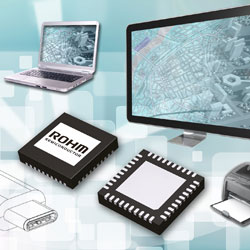Rohm has developed a new power receiver controller IC that is compatible with the latest USB Power Delivery (Rev2.0) and Type-C (Rev1.1) standards. The BM92TxxMWV series not only supports conventional USB power supplies up to 7.5W, but also newly expands the power range for USB Type-C connected devices and up to 100W (20V / 5A). This will allow devices with larger power requirements, such as TVs and PCs, to be driven via USB while charging traditional USB-equipped portable devices (such as smartphones, tablets) at a rate four times faster than previous standards. , The company said.
In recent years, for example, by utilizing or developing universal connectors and chargers for various electronic devices, there is an increasing demand for reducing electronic waste in many regions including Europe. As a result, the USB-IF (USB Implementers Forum) has developed the latest USB connectors and power transfer standards, including USB Type-C, USB Power Delivery (and USB Superspeed), and the new DisplayPort Alternate Mode standard for video transmission As a true all-in-one cable solution, they are attracting more and more attention because it can simultaneously transmit high power, high speed data and even 4K video through a single USB cable / port. This will eliminate the need for dedicated cables and provide greater convenience while reducing clutter and waste.
Combined with the new Type-C connector (with a smaller, reversible, and reversible cable design that is suitable for both laptops and robust enough to be used in mobile phones), plus USB PD, it can be extended through a variety of power supply methods Power supply, thus achieving a universal, future-oriented interface. ROHM uses leading BiCDMOS process and circuit technology to develop USB PD controller ICs optimized for these latest USB standards.
Features: 1. Supports up to 100W power supply using USB Type-C connector With the new Power Delivery standard, by determining the power contract of the provider (power supply), the two-way optimal power supply between the USB Type-C connected systems and Consumer (receiver) equipment. This achieves maximum efficiency because the consumer only requests the required amount of electricity, and the provider only provides the available amount of electricity. Other advantages include multiple scalable power transfer modes from 7.5W ( 5V@1.5A ) to 100W (20V @ 5A), which can drive larger electronic devices such as TVs and laptops, while supporting existing USB-equipped batteries The charging speed of the driving device is more than 4 times of the previous standard.
2. DisplayPort standby mode compatibility eliminates the need for a dedicated video cable, and also provides support for DisplayPort standby mode, which can transmit video signals via USB, eliminating the need for a dedicated video cable. The ability to transmit high-speed data, video, and unprecedented power over a single cable represents a breakthrough achievement that promises to improve convenience while greatly reducing clutter and waste.
3. Fewer parts required Utilizing advanced 0.13um micro BiCDMOS process and circuit technology to achieve greater compactness and optimization. This will make it possible to eliminate FETs and separate power for power receiving operations. Compared with standard systems, the number of external components can be reduced by more than 20 (including external power ICs), which contributes to further miniaturization.
The company said that samples are now available and the number of OEMs is set for December.
What is USB Power Delivery? USB power extension standard, can provide up to 100W power through USB. This allows conventional devices to fail to power larger devices such as laptops and greatly reduces the charging time of portable devices. Under the USB PD protocol, connected devices negotiate power requirements and contract to determine optimal voltage and current levels. USB PD communication requires a new dedicated CC line, whose function is independent of conventional USB data transmission.
USB Type-C standard (Type-C connector) USB Type-C is defined under USB3.1 and is a new type of socket (female connector), plug (male connector) and cable standard, with more compact , Reversible, reversible design. Unlike previous standards that required Type B connectors to be connected to downstream equipment and Type A connectors on upstream equipment, Type C cables are the same at both ends, and the power requirements are negotiated between connected equipment to determine upstream and Downstream-facing ports (UFP and DFP ad management systems) to provide greater convenience and practicality.
USB Implementers Forum, Inc. (USB-IF), a standards promotion organization, was established in 1995 to support the creation, management, and adoption of the USB standard. Currently, USB-IF has more than 800 member companies and will continue to help bring USB-compliant devices to the market.
